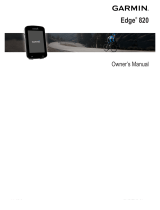
Table of Contents
Introduction.....................................................................1
Getting Started............................................................................1
Charging the Device................................................................... 1
About the Battery................................................................... 1
Installing the Standard Mount..................................................... 1
Installing the Out-Front Mount.................................................... 1
Releasing the Edge................................................................2
Turning On the Device................................................................ 2
Keys....................................................................................... 2
Acquiring Satellite Signals.......................................................... 2
Training........................................................................... 3
Going for a Ride..........................................................................3
Alerts...........................................................................................3
Setting Range Alerts.............................................................. 3
Setting a Recurring Alert........................................................ 3
Workouts.....................................................................................3
Following a Workout From the Web.......................................3
Creating a Workout................................................................ 3
Repeating Workout Steps...................................................... 4
Starting a Workout................................................................. 4
Stopping a Workout............................................................... 4
Editing a Workout...................................................................4
Deleting a Workout................................................................ 4
About the Training Calendar....................................................... 4
Using Garmin Connect Training Plans...................................4
Using Virtual Partner®................................................................ 4
Courses...................................................................................... 4
Creating a Course on Your Device........................................ 4
Following a Course From the Web........................................ 4
Tips for Training with Courses............................................... 5
Displaying a Course on the Map............................................ 5
Changing the Course Speed................................................. 5
Stopping a Course................................................................. 5
Deleting a Course.................................................................. 5
Segments....................................................................................5
Strava™ Segments................................................................ 5
Downloading a Segment from the Web................................. 5
Enabling Segments................................................................ 5
Racing a Segment................................................................. 5
Viewing Segment Details....................................................... 5
Segment Options................................................................... 5
Deleting a Segment............................................................... 6
Personal Records....................................................................... 6
Restoring Your Personal Records......................................... 6
Training Zones............................................................................ 6
Setting Your Speed Zones..................................................... 6
ANT+ Sensors................................................................. 6
Putting On the Heart Rate Monitor............................................. 6
Setting Your Heart Rate Zones.............................................. 6
About Heart Rate Zones........................................................ 6
Fitness Goals......................................................................... 6
Tips for Erratic Heart Rate Data.............................................7
Installing the Speed Sensor........................................................ 7
Installing the Cadence Sensor.................................................... 7
About the Speed and Cadence Sensors............................... 7
Installing the GSC™ 10.............................................................. 7
About the GSC 10.................................................................. 8
Data Averaging for Cadence or Power.................................. 8
Training with Power Meters........................................................ 8
Setting Your Power Zones..................................................... 8
Calibrating Your Power Meter................................................ 8
Pedal-Based Power............................................................... 8
Using Shimano® Di2™ Shifters................................................. 8
Situational Awareness
................................................................ 8
Pairing Your ANT+ Sensors....................................................... 9
Pairing a Heart Rate Monitor...................................................... 9
Using the Weight Scale.............................................................. 9
Garmin Index™ Smart Scale Data.........................................9
History............................................................................. 9
Viewing Your Ride...................................................................... 9
Viewing Data Totals............................................................... 9
Sending Your Ride to Garmin Connect...................................... 9
Garmin Connect..................................................................... 9
Bluetooth® Connected Features......................................... 10
Sending a Ride to Your Smartphone................................... 10
Deleting History........................................................................ 10
Data Recording......................................................................... 10
Changing the Data Storage Location................................... 10
Installing a Memory Card..................................................... 10
Data Management.................................................................... 10
Connecting the Device to Your Computer........................... 10
Transferring Files to Your Device........................................ 10
Deleting Files....................................................................... 11
Disconnecting the USB Cable..............................................11
Navigation..................................................................... 11
Locations.................................................................................. 11
Saving Your Location........................................................... 11
Saving Locations from the Map........................................... 11
Navigating to a Location...................................................... 11
Navigating to Known Coordinates....................................... 11
Navigating Back to Start...................................................... 11
Stopping Navigation............................................................. 11
Projecting a Location........................................................... 11
Editing Locations..................................................................11
Deleting Locations............................................................... 12
Route Settings.......................................................................... 12
Selecting an Activity for Route Calculation.......................... 12
Purchasing Additional Maps..................................................... 12
Finding an Address.............................................................. 12
Finding a Point of Interest.................................................... 12
Finding Nearby Locations.................................................... 12
Topographical Maps............................................................ 12
Map Settings............................................................................. 12
Advanced Map Settings....................................................... 12
Changing the Map Orientation............................................. 12
Customizing Your Device............................................ 12
Profiles...................................................................................... 12
Updating Your Bike Profile................................................... 13
Updating Your Activity Profile.............................................. 13
Setting Up Your User Profile................................................ 13
About Lifetime Athletes........................................................ 13
Bluetooth Settings.....................................................................13
About Training Settings............................................................ 13
Customizing the Data Pages............................................... 13
Using Auto Pause................................................................ 13
Marking Laps by Position..................................................... 14
Marking Laps by Distance....................................................14
Using Auto Scroll................................................................. 14
Changing the Start Notice.................................................... 14
System Settings........................................................................ 14
GPS Settings....................................................................... 14
Display Settings................................................................... 14
Data Recording Settings...................................................... 14
Changing the Units of Measure........................................... 14
Changing the Configuration Settings................................... 15
Changing the Device Language.......................................... 15
Setting the Device Tones..................................................... 15
Time Zones.......................................................................... 15
Table of Contents i























